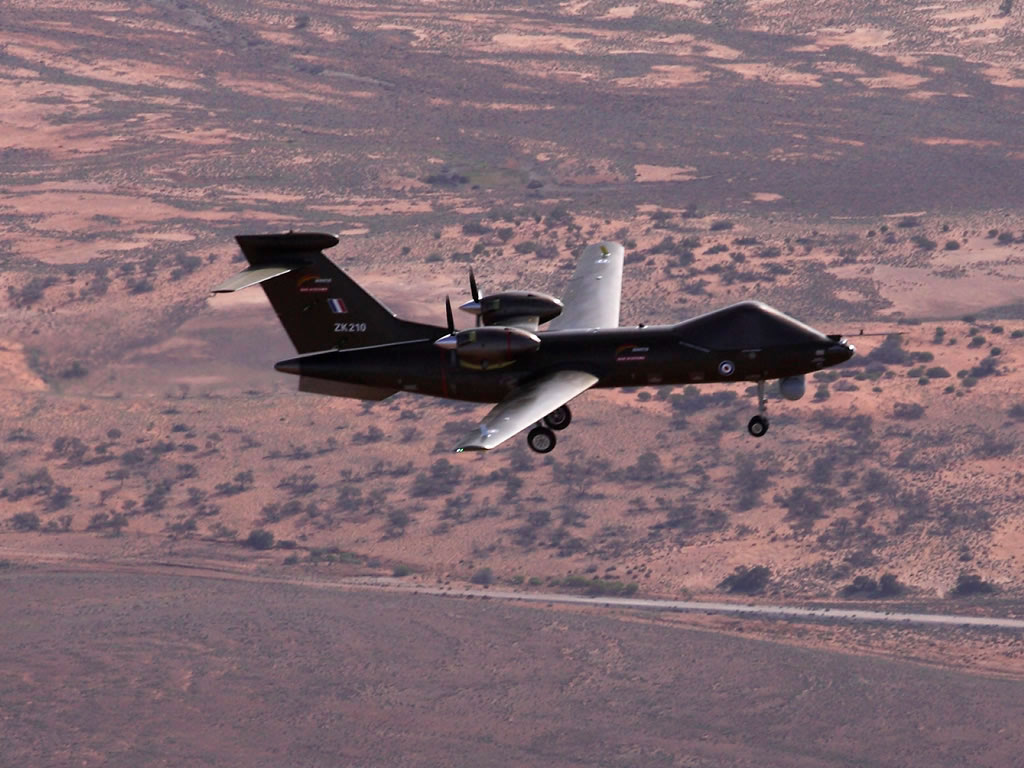BAE Systems Mantis: autonomous MALE UAV with two turboprops, optimized for ISR and combat, 24-hour endurance, six weapon hardpoints.
In brief
The BAE Systems Mantis is a medium-altitude long-endurance (MALE) unmanned aerial vehicle (UAV) developed as a technology demonstrator for the British Ministry of Defence. Powered by twin Rolls-Royce M250 turboprop engines, it can reach speeds of up to 345 mph (556 km/h) and has a maximum endurance of 30 hours. Designed for autonomous operations, the Mantis is capable of surveillance, intelligence, and direct combat roles. Its 65-foot (19.8 meters) fuselage supports six hardpoints for a variety of payloads, including sensors and guided munitions. With advanced fly-by-wire controls and satellite communications, the Mantis can perform missions with minimal human intervention, which enhances operational flexibility. It provides a robust platform for future ISR missions and potential combat deployments.
The BAE Systems Mantis
BAE Systems introduced the Mantis as part of a broader effort to develop autonomous UAV capabilities. The project began in 2007 to provide a platform capable of extended endurance and operational autonomy for both surveillance and combat. The Mantis is a response to the increasing need for persistent ISR (Intelligence, Surveillance, and Reconnaissance) capabilities and flexible unmanned platforms in military operations. Demonstrating autonomy through multiple successful flights, the Mantis continues to influence UAV development, with its design also contributing to collaborative programs such as the Telemos UAV, developed with Dassault Aviation.
History of the Development of the BAE Systems Mantis
The development of the Mantis began as BAE Systems aimed to bolster the UK’s autonomous UAV capabilities. After the initial unveiling at the 2008 Farnborough Airshow, the Mantis completed its first flight in October 2009 at the Woomera Test Range in Australia. With funding from BAE Systems and the UK Ministry of Defence, the Mantis was designed to provide the British military with a UAV that could independently handle ISR tasks and potentially strike targets. The UAV represents a significant step in British autonomous aircraft technology, given its ability to plan and execute missions with minimal ground control intervention.
The Mantis was developed with advanced modularity, making it adaptable for various mission profiles. This flexibility was demonstrated during trials, where it successfully conducted autonomous flights, managing takeoff, mission execution, and landing autonomously. Despite its technological achievements, funding challenges ultimately limited the Mantis to its demonstrator role, as priority shifted towards fielding the Reaper UAV for active service. However, the Mantis remains a critical technological foundation for future UAV development in the UK, including the Telemos program.
Design of the BAE Systems Mantis
The Mantis features a conventional design with a domed front section that houses communications equipment instead of a cockpit, as well as a T-tail configuration. The airframe, measuring 65 feet (19.8 meters) in length with a wingspan of 66 feet (20 meters), is built for efficiency and stability. Its twin-engine configuration, with engines mounted as pushers along the fuselage, reduces noise and enhances stealth capabilities.
Equipped with six hardpoints, three on each wing, the Mantis can carry various payloads, including sensors, cameras, and precision-guided munitions. Its control systems are highly autonomous, allowing for real-time mission adjustments based on onboard systems rather than operator commands. This autonomy is supported by satellite communications, which enable long-range operations and data relay without constant manual control. BAE Systems integrated a comprehensive suite of sensors and avionics, making the Mantis capable of performing ISR as well as tactical support roles.

Performance of the BAE Systems Mantis
The Mantis is powered by two Rolls-Royce M250-B17 turboprop engines, each generating 380 horsepower. This configuration allows the UAV to achieve a top speed of 345 mph (556 km/h) and maintain cruise speeds of around 230 mph (370 km/h). It has a maximum altitude of 55,000 feet (16,764 meters) and an endurance of 30 hours, making it competitive with other MALE UAVs like the MQ-9 Reaper.
The UAV’s endurance allows it to cover vast areas without refueling, while its autonomous capabilities enable operations in various weather conditions and over hostile terrain. Although it has not entered full production, the Mantis demonstrated robust performance during testing. It can engage in long-duration ISR missions and carry out targeted strikes with precision-guided munitions. This versatility and range make it suitable for extended missions, including coastal surveillance and border security.
Variants of the BAE Systems Mantis
The Mantis primarily exists as a demonstrator, but it has influenced other UAV programs. A proposed variant, developed in collaboration with Dassault, was the Telemos UAV, designed to further enhance MALE capabilities. The Telemos project aimed to improve on Mantis’ operational features and integrate additional weapon systems for broader roles.
As a demonstrator, the Mantis remains a singular prototype, but its technology underpins advancements in other BAE UAV projects like the Taranis and HERTI. These adaptations focus on enhancing autonomous functions and developing armed variants for future operational needs.
Military Use and Combat of the BAE Systems Mantis
Though the Mantis has not seen active combat, it was developed to fulfill roles in ISR and combat support. Its ability to carry up to six weapons, such as Brimstone missiles and Paveway bombs, allows it to perform precision strikes if needed. The UAV’s design, featuring real-time ISR capabilities and autonomous mission execution, supports close-air support and interdiction roles, making it valuable in scenarios requiring minimal human oversight.
The Mantis shares control infrastructure with other BAE Systems UAVs, which simplifies integration into existing command networks. During trials, the Mantis demonstrated potential for armed reconnaissance missions, though budgetary constraints limited further development. As a technology demonstrator, Mantis has influenced the UK’s unmanned systems and continues to provide insights into future UAV requirements and capabilities.
Back to the Drones, UAVs, UCAVs page